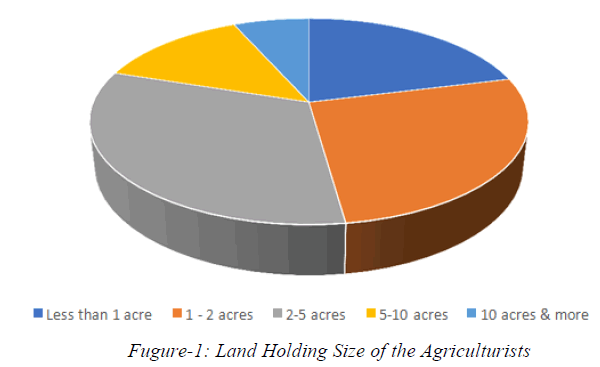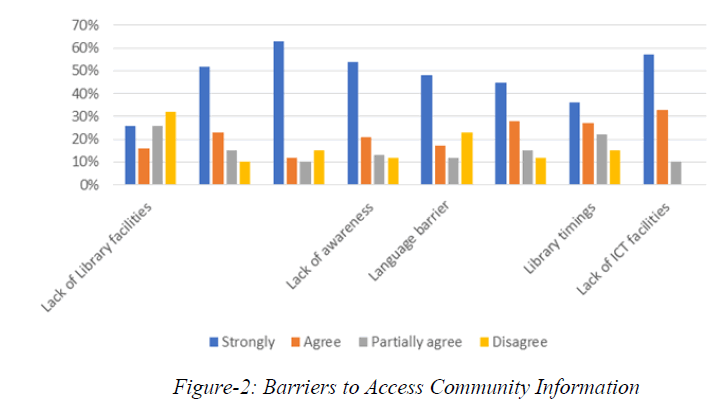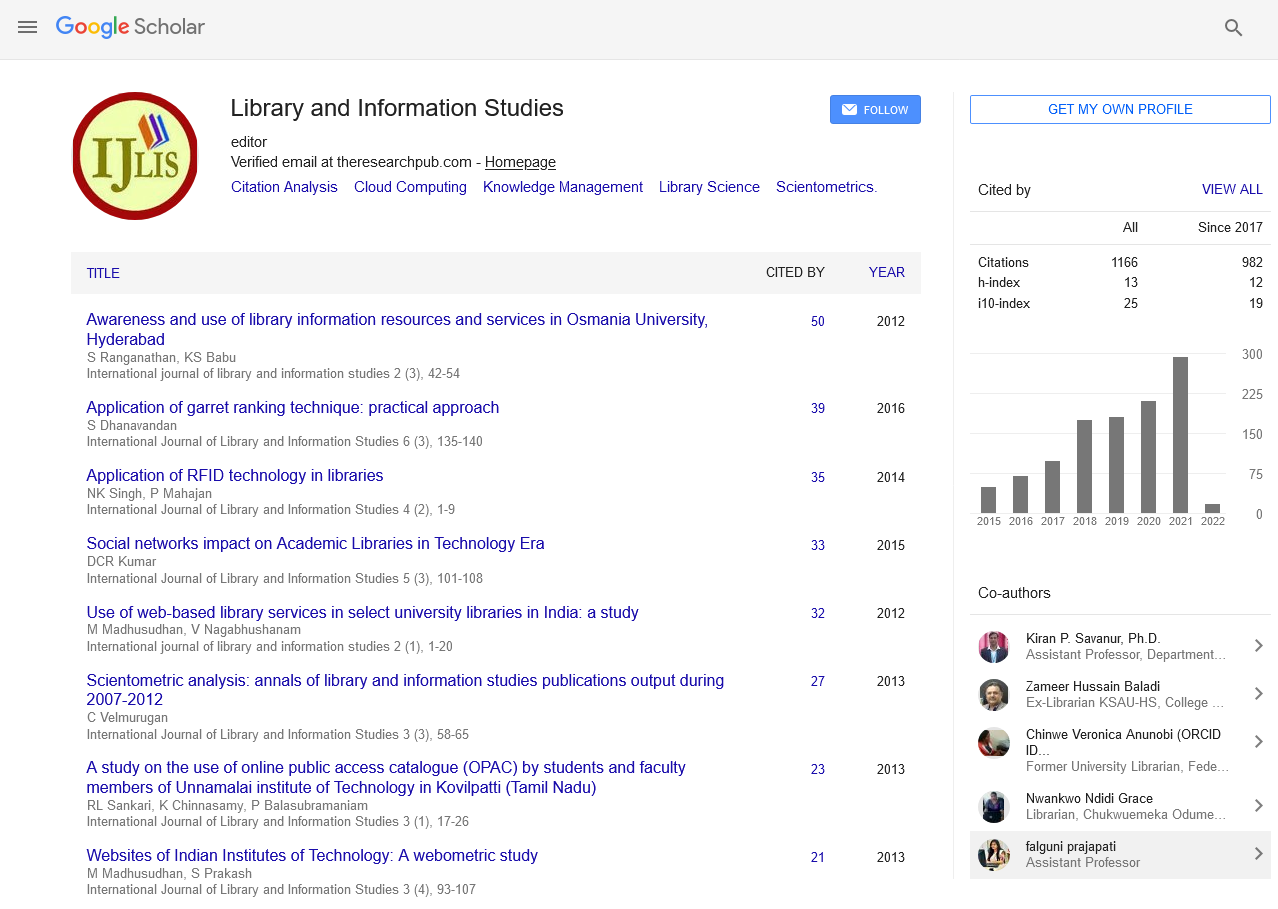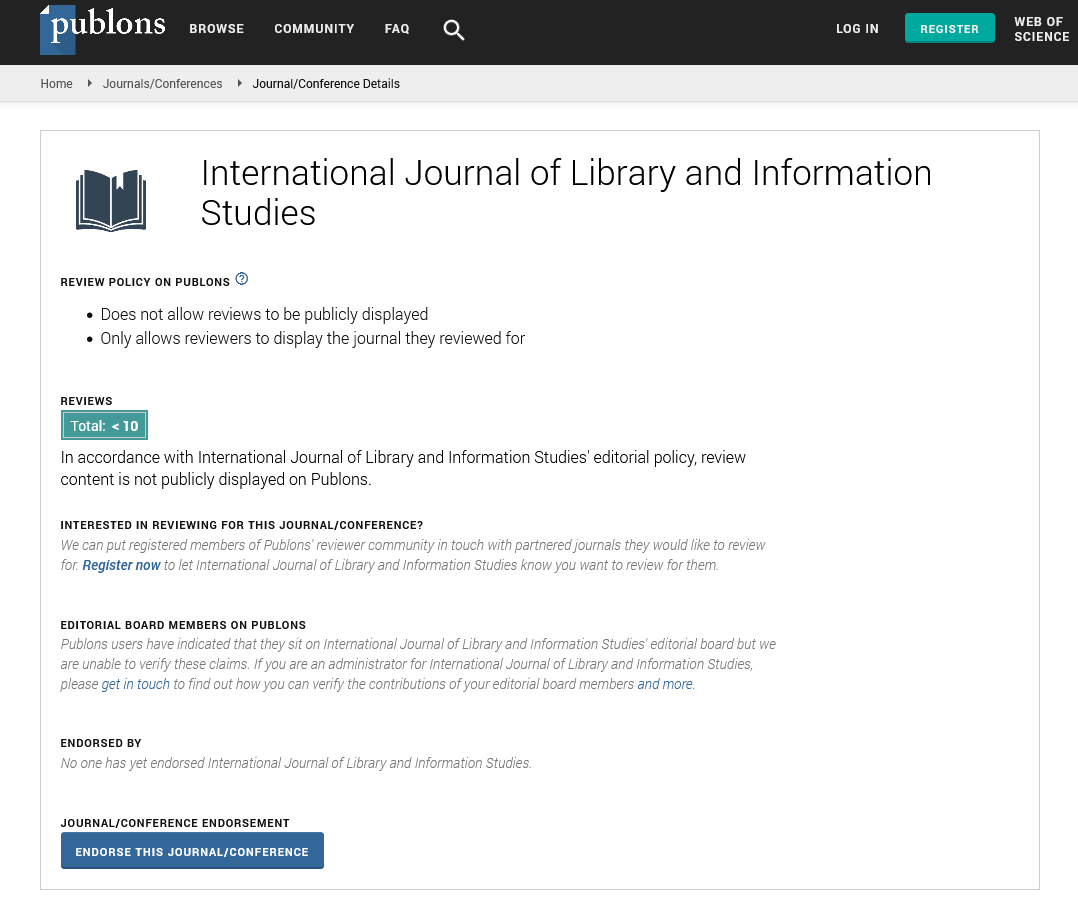Research - (2022) Volume 12, Issue 1
Barriers to Accessing Community Information by Agriculturists in Mysore Region: A Study
Siddaramu P* and S. Padmamma*Abstract
Community information services are initiated by the public libraries to facilitate the people with relevant information for day-to-day life. The purpose of this paper is to investigate the barriers in accessing community information by the agriculturists in Mysuru District. A simple random method was used to select the respondents of agriculturists from Mysuru District. The SPSS and Microsoft Excel Spread Sheet were used for analyzing the collected data. The paper explains the background of agriculturists in the Mysuru District. It highlights the lack of library facilities, agricultural information resources, non-availability of simple reading materials, lack of awareness, language, lack of library staff and their attitude towards the users’, library timings and the ICT facilities are the obstacles. It is observed that various barriers in access to CI are led to socio, economic and cultural developments. This paper gives various strategies to reduce the barriers to accessing community information by agriculturists.
Keywords
Agriculturists, Community Information, Barriers, Accessing.
Introduction
The information which helps to solve the day-to-day problems of the community is called community information (CI). In this regard, the public library plays a vital role in providing community information services to agriculturists. CI supports the survival of life and enhances the productivity, profitability, stability, and sustainability of the major cultivating systems. The public library is the only center that can act as a community information center for society as well as agriculturists to accomplish the community information needs. The agriculturists must be able to get community information served to them at the right time for the implementation of modern technology in agricultural practices. UNESCO Public Library Manifesto, 1994 provides new guidelines for public libraries as community information center. While proclaiming UNESCO’s belief in the public library as a living force for education, culture and information, the Manifesto, asserts that the public library is the local center of information, ensuring access of citizens to all sorts of community information.
According to Allan Bunch, who first attempted systemization of CISs, the CI can broadly divide into two groups is Survival information such as health, housing, income, legal protection, economic opportunities, political rights, civil rights etc. Citizen action information, needed for effective participation as individuals or as members of a group in the social, political, legal, and economic process. It includes basically public policy information such as information about the government, and its operation, programmes, plans, schemes, activities, agencies etc. This information at the local level and trans-local level will help community development.
Objectives of the study
The following are the objectives of the study which aim:
1. To know about the background of agriculturists in Mysuru District.
2. To find out the barriers in accessing community information by agriculturists.
3. To find out the strategies to reduce the barriers in accessing community information to the agriculturists.
Literature Review
Peter O. Siyao (2012) carried out a study to find out various barriers in accessing agricultural information by Sugar Cane Growers. The survey had investigated respondents’ educational level, household assets by sex and various obstacles in accessing agricultural information. The study observed that agriculturists were very much interested in accessing agricultural information in their localities for their agricultural practices. It is recommended that providing free access for relevant and accurate agricultural information in time through proper channels will help the farmers to make the right decisions for the development of agriculture in all stages.
Bachhav, Nitin Bhagachand (2012) Conducted a survey to examine the information needs of rural farmers in Maharashtra. It reveals that the majority of farmers need information for their regular agriculture work. There is lot of information sources available for the farmers, but the first preferred sources of information are colleagues or fellow farmers followed by daily newspapers and Government office.
Ugah, Akobundu Dike (2007) this paper discusses the obstacles to information access and use in developing countries. It is mentioned that information explosion, lack of awareness, inaccessibility, bibliographic obstacles, poor infrastructure, environment, declining budgets, crime, rising costs and staff attitude towards the users are the obstacles to access Information. It is suggested that there are no specific solutions for the library to remove these obstacles. The library staff must examine the barriers related to information access and overcome such barriers by providing required information.
Anwarul Islam, Dr. Muhammad Mezbah-ul-Islam (2010) Concentrates on the importance of public library in providing community information services in Bangladesh. The study reveals that the majority of the people who live in rural areas are still suffering from poverty, literacy and health problems. The study suggested that the government of Bangladesh to emphasize community information services for the rural people to improve the living standards and abolish illiteracy. The public library has to play a major role to initiate community information services to overcome all these problems.
Gupta, Sangita; Kaur, Kulwinder (2013) Community Information Centers (CICs) are established to create awareness of Information Technology (IT) among people of Jammu division at the grass-root level. The author discusses the major responsibilities of CICs in providing the required information to the users in different blocks. The paper emphasizes the aim of users’ visits to CICs and their level of satisfaction towards the services. The authors have suggested various steps for the effective implementation of CIC and to bridge the digital divide among the people of different blocks in Jammu.
Methodology
The study is based on the survey method the questionnaires were prepared to collect primary data in the study. The questionnaires were administered among the agriculturists. To get more data face-to-face interviews and group discussions were also conducted. The collected data was analyzed using SPSS and Microsoft Excel Spread Sheet.
Scope and limitation of the study
Karnataka State has four Regions, Mysuru, Bangalore, Gulbarga and Belgaum. Mysore Region comprises eight districts of Mysuru, Mandya, Kodagu, Chamarajanagar, Hassan, Chikmagalur, Dakshina Kannada, and Udupi. The study focused only on the agriculturist community of Mysuru District, not the entire population of the whole region.
Analysis and interpretation of data
The data collected from the agriculturists were analyzed and presented in the following components;
The age distribution of the agriculturists who have been involved in this study is presented in Table 1. The highest percentage 38 (42.22%) of the agriculturists were the age group of between 31-45 years followed by the age groups of 46-55 years 26(28.89%), the age group of 18-30 years are 21(23.33) and age group of from 56 years and above are only 5 (5.56%).
| Age | No | % |
|---|---|---|
| 18-30 | 21 | 23.33 |
| 31-45 | 38 | 42.22 |
| 46-55 | 26 | 28.89 |
| 56-above | 05 | 5.56 |
| Total | 90 | 100 |
Table 1: Age Group of the Agriculturists
Table 2 reveals the educational level of the agriculturists; the respondents are categorized into four main groups based on their educational level. The majority of respondents 43 (47.78%) are attained above to the high school, followed by 24 (26.67% are pass out up to high school, while 15 (16.67%) are graduate and above and only 8 (8.88%) of the agriculturists are found illiterate in the study. In order to get the background information about the agriculturists, questions were asked regarding their age, education level, language is known and the size of the land holding.
| Group | Response | Percentage |
|---|---|---|
| Illiterate | 08 | 8.88 |
| Up to high school | 24 | 26.67 |
| Above high school | 43 | 47.78 |
| Graduate and above | 15 | 16.67 |
| Total | 90 | 100 |
Table 2: Educational Level of Agriculturists
In Table 3 all the agriculturists know the Kannada language which is the mother tongue of the agriculturalists. English is understood by 21 (23.33%) whereas 13(14.44%), responded they understood Hindi also.
| Language | No | % |
|---|---|---|
| Kannada | 90 | 100 |
| English | 21 | 23.33 |
| Hindi | 13 | 14.44 |
| Others | 00 | 100 |
Table 3: Language Known to Agriculturists
Table 4 and Figure 1 reveals that 29 (32.22%) of agriculturists do have 2-5 acres of land followed by 24 (26.67%) having the land holding size of 1-2 acres, 19 (21.11%) having less than 1 acre, 12 (13.33%) having 5 to 10 acres and only 06 (6.67%) of the agriculturists are holding 10 acres and more. It is found that the land holding size of the agriculturists is very less.
| Size of land holding | No. | % |
|---|---|---|
| Less than 1 acre | 19 | 21.11 |
| 1-2 acres | 24 | 26.67 |
| 2-5 acres | 29 | 32.22 |
| 5-10 acres | 12 | 13.33 |
| 10 acres and more | 06 | 6.67 |
| Total | 90 | 100 |
Table 4: Land Holding Size of the Agriculturists

Figure-1: Land Holding Size of the Agriculturists
Table 5 shows that 61(54.90%) of the agriculturists expressed their opinion that library facilities are available in their locality and 29(26.10%) of agriculturists say that library facilities are not available in their villages.
| Replay | Response | Percentage |
|---|---|---|
| Yes | 61 | 54.90 |
| No | 29 | 26.10 |
| Total | 90 | 100 |
Table 5: Availability of Public Library Facilities in their Locality
Table 6 and Figure 2 reveals that 63% of agriculturists strongly agree that lack of simple reading materials is the barrier to accessing Community Information(CI), whereas 57% are says lack of ICT facilities, 54% of agriculturists are strongly agreed that lack of awareness of CI, 52% are lacking with agricultural information resources, 48% are facing barriers with the language, 45% lacking with the library staff and their attitude, 36% lacking with library timings, 26% of agriculturists expressed that lack of Library facilities are the barriers to access CI.
| Response | Strongly | Agree | Partially agree | Disagree | Percentage |
|---|---|---|---|---|---|
| Agree | |||||
| Lack of library facilities | 26% | 16% | 26% | 32% | 100 |
| Lack of agricultural information resources | 52% | 23% | 15% | 10% | 100 |
| Lack of simple reading materials | 63% | 12% | 10% | 15% | 100 |
| Lack of awareness | 54% | 21% | 13% | 12% | 100 |
| Language barrier | 48% | 17% | 12% | 23% | 100 |
| Lack of library staff and their attitude | 45% | 28% | 15% | 12% | 100 |
| Library timings | 36% | 27% | 22% | 15% | 100 |
| Lack of ICT facilities | 57% | 33% | 10% | 0% | 100 |
Table 6: Barriers to access Community Information

Figure-2: Barriers to Access Community Information
Results and Discussion
Education
It is found that 8.88% of the agriculturists are illiterate in the study. The public library needs to play a major role to educate illiterate agriculturists because the level of education impacts on reducing the barriers to access community information.
Lack of library facilities
The study reveals that 26.10% of agriculturists are not having library facilities in their locality. The Government/Public library needs to take the necessary steps to establish more rural libraries.
Agriculturists do believe having a Library in their localities may help them to solve their day-today problems.
Lack of agricultural information resources
The agriculturists are reported that less availability of agricultural information in the library impacts access to community information, Public library needs to concentrate on the collection development of agricultural information resources to reduce the barriers.
Lack of simple reading materials
It is found that 63% of agriculturists strongly agree that the lack of simple reading materials is the barrier to accessing community information. The public library needs to collect community information resources in simple reading form and it should be prepared such as pamphlets, broachers, and distributed freely to agriculturists at an affordable price.
Language barriers
It is found that 48% of the respondents strongly agree that language is one of the barriers to access CI. The public library has to play a major role to develop more collections in the Kannada language because 100% of the agriculturists know Kannada which is the mother tongue of the agriculturists in Mysuru District.
Lack of awareness
The study reveals that 54% of respondents strongly agree that lack of awareness about the community information is the barrier to access. Thus, the public library is required to initiate awareness programs about the availability of community information in their library by conducting exhibitions of agricultural resources, arranging talks, the celebration of farmer’s day, training programs, seminars and workshops.
Lack of library staff
It’s found that 45% of respondents strongly expressed their opinion that lack of Library staff and their attitude is the barrier to access community information. The public library needs to provide additional qualified and dedicated staff at the rural library to reduce the barriers to access.
Library timings
The study found that most of the rural libraries keep open only from mooring 8 am to 12 pm and evening 4 pm to 8 pm. The agriculturists responded that opening timings of the library are also barriers to access community information. It is recommended that rural libraries should be kept open from mooring 8 am to 8 pm to use library facilities effectively in their leisure time.
Lack of ICT facilities
Today, Information and Communication Technology (ICT) has brought remarkable enhancements in the agricultural sector. It helps agriculturists to implement modern technology in agricultural practices. In this study, agriculturists reported that lack of ICT facilities is one of the barriers to accessing CI. The public library needs to provide ICT facilities to access community information and e-governance initiatives in the agriculture sector to reduce the barriers.
Conclusion
Community information is the basic need for the overall development of agriculturists. It can be rightly said that more access and use of CI impact social, economic and cultural development in the community. The public library has to play a vital role to remove the barriers of accessing CI by creating awareness programs and establishing more community information centers with the required agricultural resources and services.
References
- Siyao, Peter O. "Barriers in Accessing Agricultural Information in Tanzania with a Gender Perspective: The Case Study of Smallâ?Scale Sugar Cane Growers in Kilombero District." The Electronic Journal of Information Systems in Developing Countries 51.1 (2012): 1-19.
[Crossref] [Google Scholar] [PubMed]
- Uhegbu, A. N. "Deterrents to information service for community development." Library review 50. 5 (2001): 237-242.
[Crossref] [Google Scholar] [PubMed]
- Munyua, Hilda. "Application of ICTs in Africaâ??s agricultural sector: A gender perspective." Gender and the information revolution in Africa (2000): 85-124.
[Crossref] [Google Scholar] [PubMed]
- Islam, Md Anwarul, and Muhammad Mezbah-ul-Islam. "Community information services through public libraries in Bangladesh: Problems and proposals." Library Philosophy and Practice (2010): 1-11.
[Crossref] [Google Scholar] [PubMed]
- Ugah, Akobundu Dike. "Obstacles to information access and use in developing countries." Library philosophy and practice 12 (2007): 21.
[Crossref] [Google Scholar] [PubMed]
- Nitin Bhagachand Bachhav. "Information needs of the rural farmers: A study from Maharashtra, India: A survey." (2012).
[Crossref] [Google Scholar] [PubMed]
- Agwuna, Obianuju Maureen, and Uchechukwu Victoria Enweani. "Managing Community Information Centres (CICs) for Effective Provision of Health Information to Rural Women." Library Philosophy & Practice (2018).
[Crossref] [Google Scholar] [PubMed]
- Gupta, Sangita, and Kulwinder Kaur. "Usage of community information centres: a case study of Jammu division, j. & k.(India)." Library of Progress-Library Science, Information Technology & Computer 33.1 (2013).
[Crossref] [Google Scholar] [PubMed]
- Qiang, Christine Zhen-Wei. Rural informatization in China. No. 172. World Bank Publications, 2009.
[Crossref] [Google Scholar] [PubMed]
- Kaniki, Andrew M. "Community resource centres and resource centre forums in the transformation and post-transformation era in South Africa." African Journal of Library, Archives and Information Science 4.1 (1994): 47-51.
[Crossref] [Google Scholar] [PubMed]
Author Info
Siddaramu P* and S. Padmamma*Received: 07-Mar-2022, Manuscript No. IJLIS-22-56243; Editor assigned: 14-Mar-2022, Pre QC No. IJLIS-22-56243(PQ); Reviewed: 28-Mar-2022, QC No. IJLIS-22-56243; Revised: 04-Apr-2022, Manuscript No. IJLIS-22-56243(R); Published: 14-Apr-2022, DOI: 10.35248/2231-4911.22.12.825
Copyright: This is an open access article distributed under the terms of the Creative Commons Attribution License, which permits unrestricted use, distribution, and reproduction in any medium, provided the original work is properly cited.
Call for Papers
Authors can contribute papers on
What is Your ORCID
Register for the persistent digital identifier that distinguishes you from every other researcher.
Social Bookmarking
Know Your Citation Style
American Psychological Association (APA)
Modern Language Association (MLA)
American Anthropological Association (AAA)
Society for American Archaeology
American Antiquity Citation Style
American Medical Association (AMA)
American Political Science Association(APSA)





